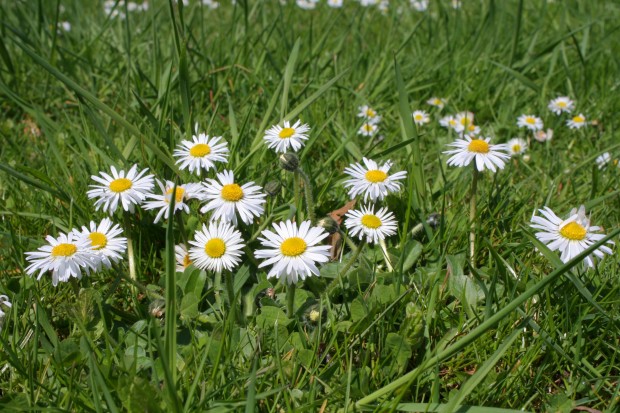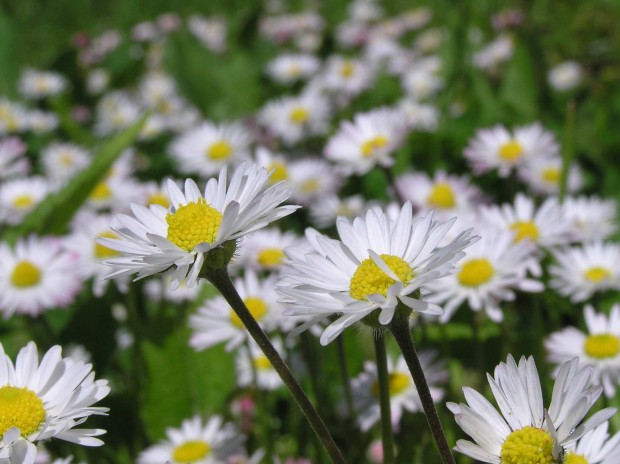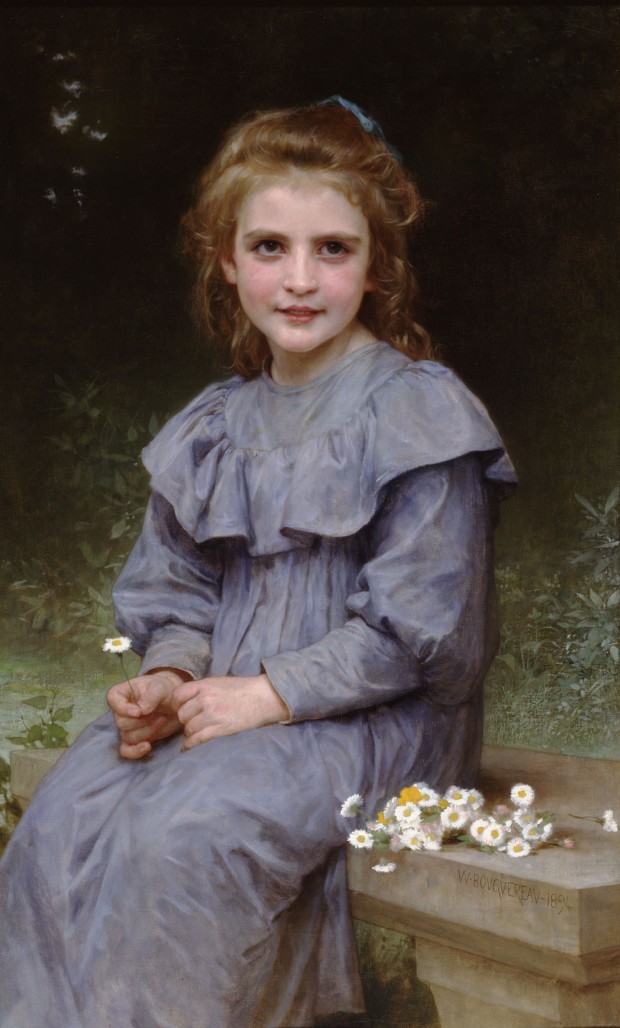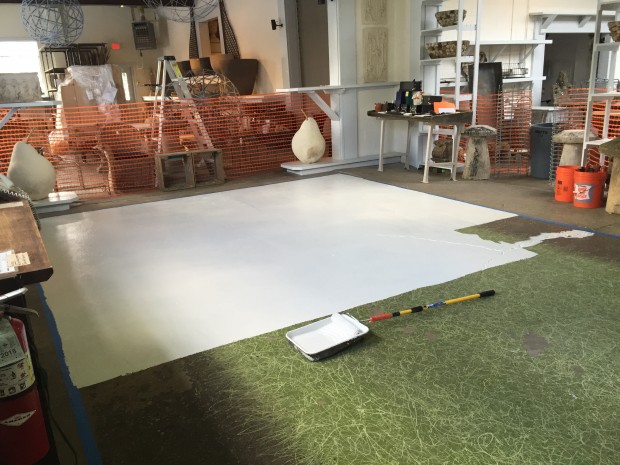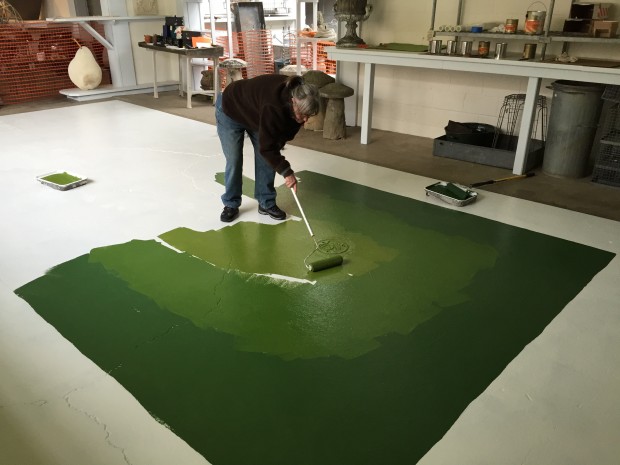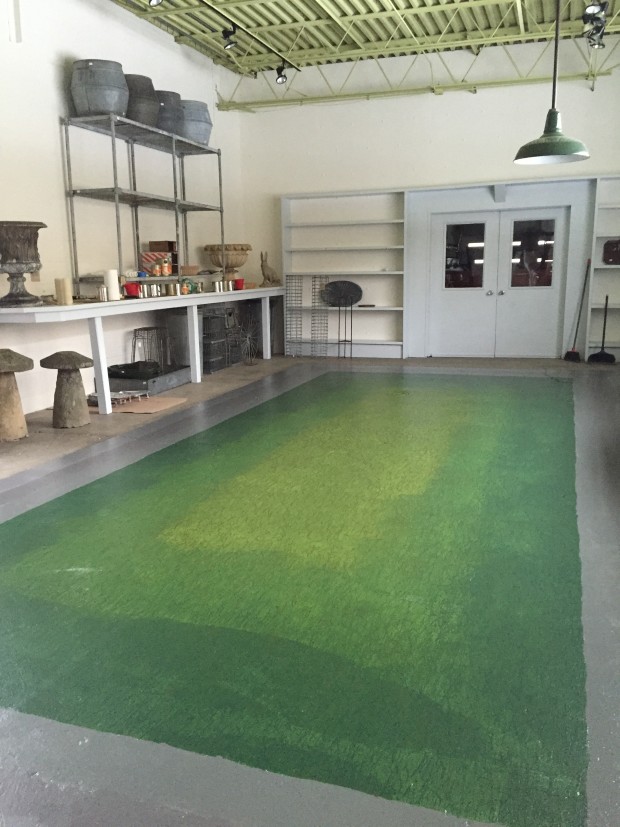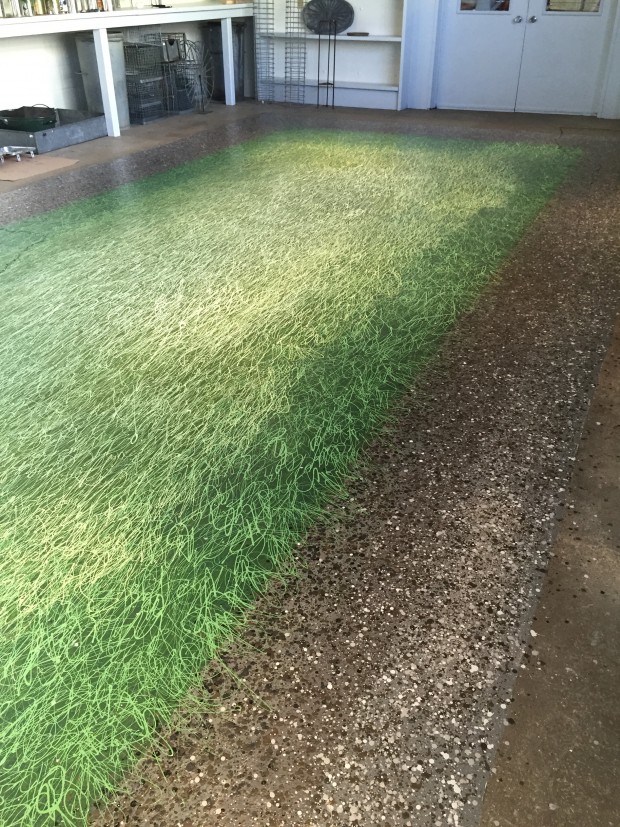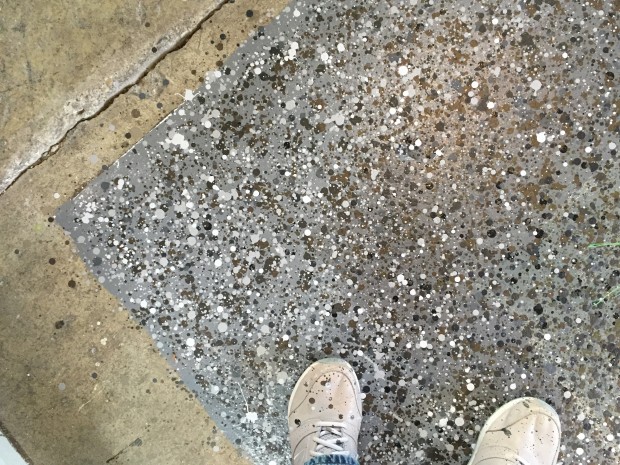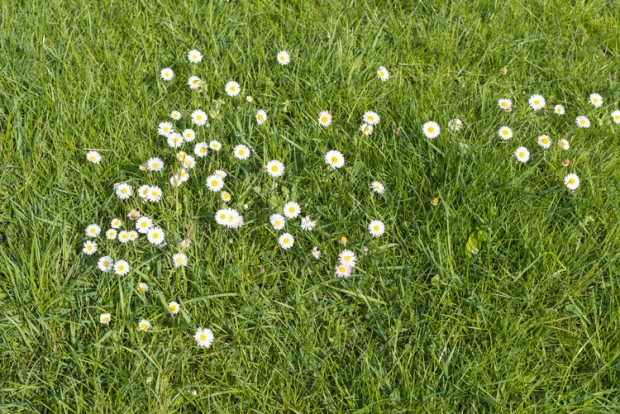 It is no accident that the subject of the painted floor at the shop is bellis perennis, or English daisy. Daisies are a favorite perennial plant of mine. Bellis is the original plant to which the name daisy was applied. This daisy spread throughout Europe and eventually made its appearance in North America. The yellow disc like center with a star of radiating petals is characteristic of all daisies. As you can see in this picture from Wikipedia, the flowers are the small yellow structures you can see at the edge of the yellow disk in the picture above. The flowers are surrounded by white bracts, radiating all around. Daisies are a member of the aster family. The word aster comes from the Greek word meaning “star”. The aster family is commonly known as the family of daisies.
It is no accident that the subject of the painted floor at the shop is bellis perennis, or English daisy. Daisies are a favorite perennial plant of mine. Bellis is the original plant to which the name daisy was applied. This daisy spread throughout Europe and eventually made its appearance in North America. The yellow disc like center with a star of radiating petals is characteristic of all daisies. As you can see in this picture from Wikipedia, the flowers are the small yellow structures you can see at the edge of the yellow disk in the picture above. The flowers are surrounded by white bracts, radiating all around. Daisies are a member of the aster family. The word aster comes from the Greek word meaning “star”. The aster family is commonly known as the family of daisies.
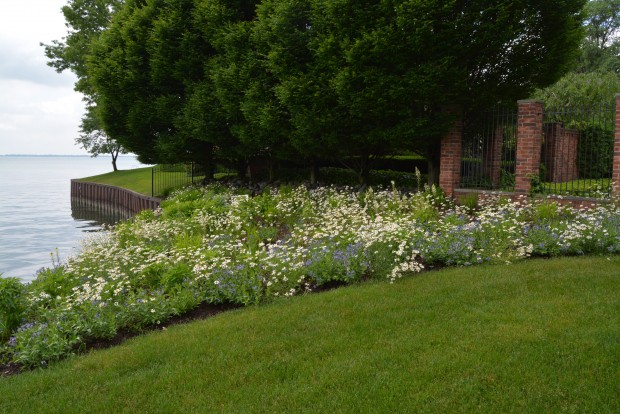 The aster family is reputed to make up almost 10% of all flowering plants. That is a staggering number. Not every member of the aster family looks like a daisy. Sunflowers and echinacea have that daisy look, but artichokes do not. The English daisy is a lawn weed for some that I greatly admire. In my garden it is charming, and not so much weedy. Just as weedy is the perennial oxeye daisy. Leucanthemum vulgare acts just very much like its name. It is a tall rangy grower that will eventually flop over if it does not have support from its neighbors. It is native to every state in the US, and all of Canada. I would call that willing. This native roadside daisy is prohibited in some states-mostly for agricultural reasons. They can act as a host for viral diseases of crops. Cattle avoid eating them. That said, I have planted them. This loosely configured perennial garden on the lake features the oxeye daisy, as well as chasmathium latifolium in the shadier areas. The taller species asters are still quite short at this time of year. The amsonia “Blue Ice” is short, but scrappy. The other perennials in this garden were chosen for their ability to withstand the advances of the daisies.
The aster family is reputed to make up almost 10% of all flowering plants. That is a staggering number. Not every member of the aster family looks like a daisy. Sunflowers and echinacea have that daisy look, but artichokes do not. The English daisy is a lawn weed for some that I greatly admire. In my garden it is charming, and not so much weedy. Just as weedy is the perennial oxeye daisy. Leucanthemum vulgare acts just very much like its name. It is a tall rangy grower that will eventually flop over if it does not have support from its neighbors. It is native to every state in the US, and all of Canada. I would call that willing. This native roadside daisy is prohibited in some states-mostly for agricultural reasons. They can act as a host for viral diseases of crops. Cattle avoid eating them. That said, I have planted them. This loosely configured perennial garden on the lake features the oxeye daisy, as well as chasmathium latifolium in the shadier areas. The taller species asters are still quite short at this time of year. The amsonia “Blue Ice” is short, but scrappy. The other perennials in this garden were chosen for their ability to withstand the advances of the daisies.
 I love our wild daisy. It is fresh, sunny spirited, and uncomplicated. Should you not require a plant that behaves in an adult like manner in an unmowed meadowy spot, they will persist. They may migrate, but any day with daisies blooming is a good day. It is hard to dislike them, even when they are a nuisance. I do not farm crops or raise cattle, so I do plant oxeye daisies-primarily the cultivar known as “May Queen”. Do not plant an oxeye daisy if you want order in the court. If introducing a wild daisy with a long agenda to your garden makes you uneasy, the wild shasta daisy, leucanthemum maximum, is a better mannered choice. The first hybrid shasta daisy was bred by Luther Burbank, who spent 15 years crossing various wild daisies, in search of a worthy garden plant. They all feature big white star like flowers with yellow button centers. Not every gardener has the space or patience for wilding daisies.
I love our wild daisy. It is fresh, sunny spirited, and uncomplicated. Should you not require a plant that behaves in an adult like manner in an unmowed meadowy spot, they will persist. They may migrate, but any day with daisies blooming is a good day. It is hard to dislike them, even when they are a nuisance. I do not farm crops or raise cattle, so I do plant oxeye daisies-primarily the cultivar known as “May Queen”. Do not plant an oxeye daisy if you want order in the court. If introducing a wild daisy with a long agenda to your garden makes you uneasy, the wild shasta daisy, leucanthemum maximum, is a better mannered choice. The first hybrid shasta daisy was bred by Luther Burbank, who spent 15 years crossing various wild daisies, in search of a worthy garden plant. They all feature big white star like flowers with yellow button centers. Not every gardener has the space or patience for wilding daisies.
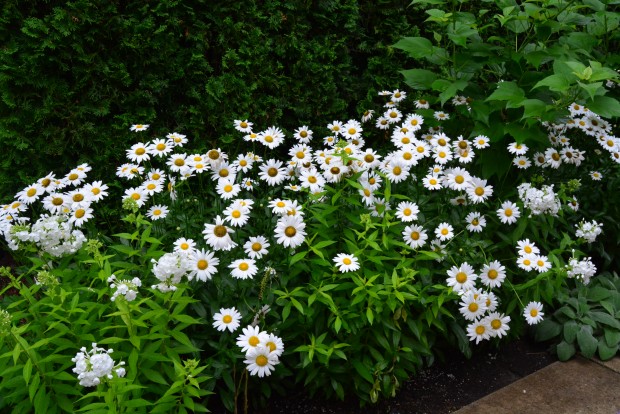 The shasta daisy “Becky” is a sturdy and persistently perennial improvement over the classic tall shasta “Alaska”. I say improved, as I like the somewhat shorter height of Becky. In this garden, it is entirely companionable with the white tall phlox “David”. They make great cut flowers. They don’t ask for much in the way of care. White flowers in the perennial garden provide punctuation to the sentence “This is a garden”. That white is visible from a great distance. The flowers are not fancy.
The shasta daisy “Becky” is a sturdy and persistently perennial improvement over the classic tall shasta “Alaska”. I say improved, as I like the somewhat shorter height of Becky. In this garden, it is entirely companionable with the white tall phlox “David”. They make great cut flowers. They don’t ask for much in the way of care. White flowers in the perennial garden provide punctuation to the sentence “This is a garden”. That white is visible from a great distance. The flowers are not fancy.
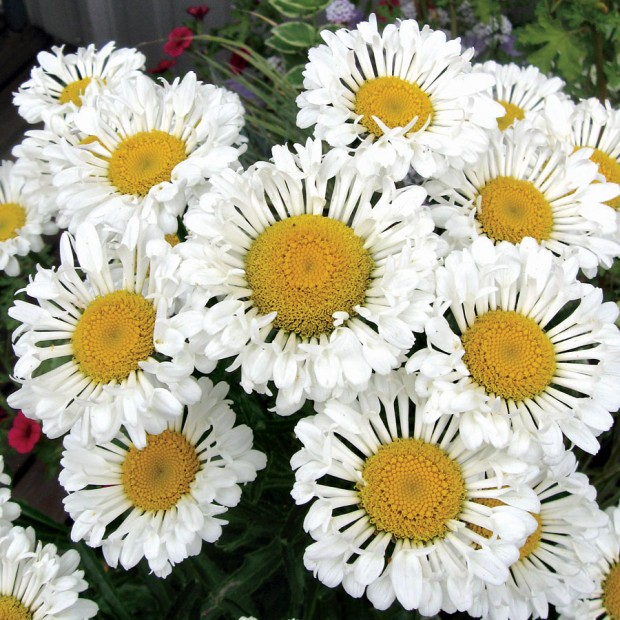 This cultivar, chrysanthemum superbum “Real Neat” is available from Wayside Gardens, is a daisy whose breeding has gone over to the fancy side. The best part is that gardeners of all persuasions will be able to find a daisy to their liking.
This cultivar, chrysanthemum superbum “Real Neat” is available from Wayside Gardens, is a daisy whose breeding has gone over to the fancy side. The best part is that gardeners of all persuasions will be able to find a daisy to their liking.
 Chrysanthemums are in the aster family. Certain varieties of chrysanthemums have a distinctly daisy-like appearance. This variety, Sheffield Pink, is the latest perennial to bloom on my block. It was planted underneath a tree in my neighbor’s yard. The tree died a few years ago, but this daisy mum still comes back and blooms in October, just like it has for at least 15 years.
Chrysanthemums are in the aster family. Certain varieties of chrysanthemums have a distinctly daisy-like appearance. This variety, Sheffield Pink, is the latest perennial to bloom on my block. It was planted underneath a tree in my neighbor’s yard. The tree died a few years ago, but this daisy mum still comes back and blooms in October, just like it has for at least 15 years.
 Sheffield Pink is not only hardy, it is persistent. I do not see that it gets any special care, but for the fact that my neighbor mows carefully around it. It gets water from the sky, or maybe the hose on occasion. I never see any evidence of disease or ill health. Many daisies are like this. Given a good start, a well grown stand of daisies is sure to come.
Sheffield Pink is not only hardy, it is persistent. I do not see that it gets any special care, but for the fact that my neighbor mows carefully around it. It gets water from the sky, or maybe the hose on occasion. I never see any evidence of disease or ill health. Many daisies are like this. Given a good start, a well grown stand of daisies is sure to come.
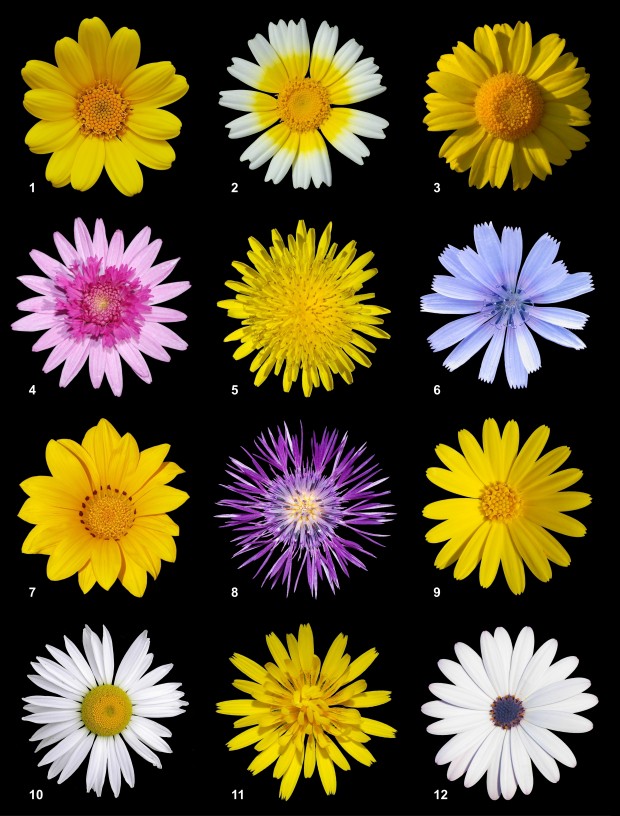 This poster via Wikipedia illustrates the great range of flower forms and colors in the aster family. No matter the particulars, daisies thrive with a minimum of care and fuss, providing they are sited in decent soil, with reasonable water, good drainage, and in full sun.
This poster via Wikipedia illustrates the great range of flower forms and colors in the aster family. No matter the particulars, daisies thrive with a minimum of care and fuss, providing they are sited in decent soil, with reasonable water, good drainage, and in full sun.
 The persistence of the daisy could be no better evidenced than in this stunning photograph taken by Jack Dykinga recently in Death Valley. An El Nino that brought rare fall rains to the desert has resulted in a Death Valley super bloom. Thousands of dormant seeds of geraea canescens, or desert gold plant, germinated following the rains. This annual daisy-like flowering plant is a member of the aster family, and is sometimes known as the desert sunflower. The article about the Death Valley super bloom is beautifully documented on the National Geographic website. Death Valley Super Bloom
The persistence of the daisy could be no better evidenced than in this stunning photograph taken by Jack Dykinga recently in Death Valley. An El Nino that brought rare fall rains to the desert has resulted in a Death Valley super bloom. Thousands of dormant seeds of geraea canescens, or desert gold plant, germinated following the rains. This annual daisy-like flowering plant is a member of the aster family, and is sometimes known as the desert sunflower. The article about the Death Valley super bloom is beautifully documented on the National Geographic website. Death Valley Super Bloom
 There are few flowers as buoyant, sunny natured, and persistent as a daisy. See what I mean?
There are few flowers as buoyant, sunny natured, and persistent as a daisy. See what I mean?
